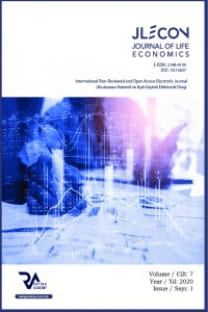TÜRKİYE’NİN İMALAT SANAYİ ÜRÜN GRUPLARINDAKİ İHRACAT REKABET GÜCÜNÜN BELİRLENMESİ: 1996-2015 DÖNEMİ ANALİZİ
Bu çalışmanın amacı, Türkiye’nin imalat sanayi ürünleri ihracatındaki küresel rekabet
gücünü, Açıklanmış Karşılaştırmalı Üstünlük (RCA) yöntemini kullanarak belirleyebilmektir. Veri seti,
SITC Rev.3, 3 dijit sınıflandırmadaki 157 mal grubuna ait ihracat verilerinden oluşmakta, zaman
aralığı ise 1996’dan 2015’e 20 yılı kapsamaktadır. Çalışmanın analizinde, Vollrath İndeksi
kullanılmış ve her bir ürün grubu için RCA katsayıları hesaplanmıştır. Elde edilen sonuçlara göre
Türkiye, 157 imalat sanayi ürün grubu ihracatından, 57’sinde rekabet avantajına, kalan diğer 100 mal
grubunda ise rekabet dezavantajına sahiptir. Türkiye’nin, rekabet avantajına sahip olduğu söz konusu
57 ürün grubundan 19’u güçlü üstünlük, 18’i orta derece üstünlük ve 20’si de zayıf üstünlük
şeklindedir. Bununla birlikte, RCA katsayılarında ikinci dönem itibari ile önemli düşüşler de söz
konusudur.
Anahtar Kelimeler:
İmalat sanayi, rekabet gücü, Vollrath İndeksi, Türkiye
DETERMINATION OF TURKEY'S EXPORT COMPETITIVENESS IN INDUSTRIAL PRODUCT GROUPS: AN ANALYSIS OVER THE PERIOD 1996-2015
The aim of this study is to determine the global competitiveness of Turkey's manufacturing
industry products by using the Revealed Comparative Advantage (RCA) method. The data set, SITC
Rev.3, consists of export data for 157 groups of goods in 3 digit classification and the time interval
covers 20 years from 1996 to 2015. In the analysis of the study, the Vollrath Index is used and the
RCA coefficients are calculated for each product group. According to the results, Turkey has a
competitive advantage in exports of 57 manufacturing industry groups, and a competitive
disadvantage in the remaining 100 commodity groups. Of the 57 product groups in which Turkey has
a competitive advantage, 19 are strong superiority, 18 are moderate superiority and 20 are weak
superiority. However, there are significant decreases in the RCA coefficients as of the second period.
Keywords:
Manufacturing, competitiveness, Vollrath Index, Turkey.,
___
- Aydoğanoğlu, E. (2011). “Emek Sürecinin Dönüşümü”. Kültür Sanat - Sen Yayınları, No:5. Ankara. Balassa, B. & Noland, M. (1989). “‘Revealed’ Comparative Advantage in Japan and the United States”, Journal of International Economic Integration, 4(2):8-22. Balassa, B. (1965). “Trade Liberalization and Revealed Comparative Advantage”. The Manchester School of Economic and Social Studies. 33(2):99-123. Bojnec, Š. & Fertő, I. (2006). “Does Comparative Advantages in Agri-Food Trade Matter for Multifunctional Rural Development: The Case of Hungary and Slovenia”. Journal of Central European Agriculture. 7(3):583-586.
- Yayın Aralığı: Yılda 4 Sayı
- Başlangıç: 2014
- Yayıncı: Rating Academy
Sayıdaki Diğer Makaleler
AVRUPA BİRLİĞİ DÖNEM BAŞKANLIĞI SİSTEMİ VE AVRUPA BİRLİĞİ POLİTİKALARINA ETKİSİ
GAZLI İÇECEK TÜKETİMİNDE TÜKETİCİLERİN MARKA ALGISININ BELİRLENMESİ: İZMİR İLİ ÖRNEĞİ
Ebru ONURLUBAŞ, Hüseyin ÇAKIRLAR
Π SAYISININ RASGELELİĞİNİN SINANMASI
TÜRK VERGİ SİSTEMİNDE VERGİ ÖDEME GÜCÜNE ULAŞMA TEKNİKLERİ
ACCESSIBILITY, ACCOUNTABILITY AND THE IMPACT OF SOCIAL ENTERPRISE
